visomat comfort eco User manual

Gebrauchsanleitung
Instructions for use
Mode d’emploi
Istruzioni per l’uso
www.visomat.de • Besser Messen.
(DE-2 - DE-29)
(EN-30 - EN-57)
(FR-58 - FR-85)
(IT-86 - IT-113)
comfort eco
K
L
I
N
I
S
C
H
V
A
L
I
D
I
E
R
T
C
L
I
N
I
C
A
L
L
Y
V
A
L
I
D
A
T
E
D

english
EN-30
english
EN-31
50
50
51
55
56
32
33
34
35
36
37
37
38
39
40
40
41
42
43
43
43
44
46
46
48
48
49
The cuff is first placed as shown in the illustration on the cuff on the upper arm
and then connected to the unit. When the Start/Stop button is pressed, the system
starts to build up pressure automatically. Within a very short space of time the
unit records the small oscillations within the cuff which occur owing to expansion
and contraction of the arteries in the arm (heartbeat).The automatic build-up of
pressure usually stops approx. 40 mmHg above the systolic value (fuzzy logic).
Then the actual measurement process starts while the cuff is being deflated. The
amplitude of each pressure wave is measured in millimetres of mercury (mmHg),
converted and displayed in the LCD as a digital value. Systole, diastole and pulse
are determined, after which the cuff is completely deflated.
Table of contents Table of contents
Thank you for choosing the visomat®comfort eco upper arm blood pressure
monitor (also referred to in the following as the unit).
visomat®comfort eco uses the oscillometric method for measuring blood pressure
and pulse rate on the upper arm.
Mode of operation:
As well as indicating systole, diastole and pulse, the unit offers additional displays
for determining irregular pulses and pulse pressure. Irregular pulses may be an in-
dication of an irregular heartbeat but also of restlessness during the measurement.
This unit is recommended to patients with unstable blood pressure for measuring
their blood pressure at home and for therapy support.
Safety instructions
Important patient instructions
Important technical details
Maintaining the unit
F
Warranty
G
Why you should measure blood pressure regularly
Systolic and diastolic blood pressure values
What you should know about blood pressure
Reasons for measuring different values
Electromagnetic compatibility (EMC)
EGeneral provisions
Explanation of symbols
Disposal
Technical information
Failure and error messages
Customer service
Technical data
Applicable standards
Metrological inspection
Using the memory
Initial operation of the unit
Inserting/replacing batteries
Attaching the cuff
Operating the unit
Unit description
Important instructions for use
Irregular pulse waves
Control displays
Pulse pressure
WHO traffic light function
Measuring blood pressure
1.
2.
1.
2.
3.
4.
5.
6.
7.
8.
9.
10.
11.
1.
2.
3.
1.
2.
3.
4.
5.
6.
Original spare parts and accessories
A
B
C
D
1.
2.
3.

english
A
EN-32
Safety instructions
EN-33
english
A
Safety instructions
Important patient instructions1.
The unit is designed for non-invasive measurement of the systolic and dias-
tolic blood pressure on the upper arm, as well as measurement of the pulse
rate of adults, i.e. 15 years of age and older. Blood pressure measurements on
children require specialist knowledge! Please consult your doctor if you wish
to measure the blood pressure of a child. Do not under any circumstances use
the unit on a baby/infant.
•
The standard cuff supplied is designed for an upper arm circumference of
22-32 cm. A larger cuff (accessory Page EN-48) is optionally available for arm
circumferences of 32-42 cm.
•
The measurement results of automatically measuring blood pressure monitors
may be falsified by pregnancy, irregular heartbeats, or arteriosclerosis. Measu-
re your own blood pressure in cooperation with your doctor.
•
Measuring your own blood pressure does not constitute treatment. Do not
modify of you own accord the dosage of drugs/medication prescribed by your
doctor.
•
Do not under any circumstances place the cuff on or over any critical point,
e.g. wound, aneurysm, etc. Risk of injuries! The supply via an intravascular
access (infusion) could possibly be interrupted.
•
Please refer to the chapter „Important instructions for use“ (Page EN-36)
before conducting any measurements yourself.
•
The unit must only be operated with original spare parts. The warranty will be
invalidated if the unit is damaged by non-approved accessories!
•
Using this unit near mobile phones, microwave ovens or other devices with
strong electromagnetic fields may lead to malfunctions. See also EMC descrip-
tion from Page EN-51.
•
The display of the pulse frequency is not suitable for checking the frequency
of cardiac pacemakers. Cardiac pacemakers and blood pressure monitors do
not influence each other regarding their mode of operation.
•
Never open or modify the unit or the cuff - this is a medical device. (Excepti-
on: replacing batteries). If the unit has been opened, it must be subjected to a
metrological inspection by an authorised institution.
•
Important technical details2.
The cuff may be inflated on the arm only.•
Please comply with the specified ambient conditions for measurement. See
Technical data, Page EN-46.
•
A constantly good power supply to the unit is necessary for trouble-free blood
pressure measurements.
•
Please use long-life alkaline batteries only (LR6).–
Always replace all batteries simultaneously during battery replacement.–
You will need 4 x 1.5 V batteries. Rechargeable batteries have a voltage of
only 1.2 V and are thus not suitable.
–
When using the unit with a mains adapter, please use the type A1 mains
adapter specially tested for medical devices only.
–
If the unit is not to be operated with batteries for an extended period of
time, remove the batteries. Essentially, all batteries can leak.
–
The inflating and measuring procedure can be stopped by pressing the
Start/Stop button. In this case, the unit stops the inflation procedure and
deflates the cuff.
•
These instructions are intended to help the user to use the blood pressure monitor
safely and efficiently manner and must be kept with the product and forwarded, if
applicable.
The unit must be used in accordance with the procedures contained in these ins-
tructions and must not be used for other purposes. Please read these instructions
carefully before using the unit.
Pulse pressure provides an indication of the stretchability of the blood vessels. A
memory stores the last 30 measurement results in each case for comparison.

english
B
EN-34
Operating the unit
EN-35
english
B
Operating the unit
Failure and error messages (page EN-44)
Err-1, -2, -3, -5
7
6
5
4
3
2
Unit description1.
Start/Stop button
Battery compartment
Connecting socket for mains adapter
Artery marking
1
Display
Air socket
Memory button
(memory recall button)
Control displays2.
2
5
3
1
6
7
6
1
2
3
7
6
5
4
3
2
Pulse signal display or irregular
pulse waves
WHO categorisation
SYS = Systole
Memory identifier
1
DIA = Diastole
PUL 1/min = Pulse calculates pulse
frequency per minute
Battery check display
10
Cuff
4
5
8
9
10
Measurement arrow for arm
circumference
Cuff
Marking for arm circumference
8
9
11
4
7
11 Air hose

english
B
EN-36
Operating the unit
EN-37
english
B
Operating the unit
Please rest at least 5 minutes before measuring. Depending on the previous
degree of stress/exertion, this can even require up to one hour.
•
Refrain from drinking alcoholic or caffeinated beverages and smoking at least
one hour before measuring.
•
Expose the upper arm, the clothes must not impair the blood flow in or from the
arm as this influences the blood pressure at the measurement point.
•
Important instructions for use3.
Resting during the measurement is absolutely essential! Talking or moving
as well as strong irregular heartbeats will affect the measurement result, the
values becoming too high.
•
Insert the supplied batteries into the unit, if these have not been inserted already.
Initial operation of the unit4.
Remove the cover of the battery compartment on the underside of the unit.
Opening the battery compartment•
Remove the old batteries from the unit and insert the new ones. Please
observe proper polarity (marking in battery compartment).
Inserting batteries•
Close the battery compartment by clipping the battery cover back into the
unit.
Closing the battery compartment•
Replace the batteries
Please note:•
if the flat battery symbol appears in the display
during or after the segment check.
–
if the display remains blank in spite of the Start/
Stop button being pressed.
–
For this purpose, sit at a table (if possible the height of a dining table, not
a coffee table!).
–
Body posture must be relaxed:•
Rest your back against the backrest of the chair.–
Lay down your lower arm completely. Make sure the palm of your hand is facing–
Place your feet on the floor and do not cross your legs.–
There should be no irregular heartbeats during the measurement! Irregular
movements, vibrations, speaking, and breathing heavily will also affect the
measurement. Listen out for regular pulse beep signals during measurement;
if necessary, repeat the measurement in improved conditions.
•
Unusual measurement results are possible with all automatically measur-
ing blood pressure measurement systems from time to time. Check yourself:
did you comply with the instructions for use above? If necessary, repeat the
measurement after allowing the blood circulation in the arm to recuperate
briefly; rest for about 3-5 minutes for this purpose. Tip: Remain seated, your
monitor will switch off automatically about 3 minutes after a measurement.
Afterwards, we recommend that you repeat the measurement.
•
If the unit is to be operated from the mains power supply, the cable plug of the
mains adapter (accessory, Page EN-48) must be inserted into the connection socket
on the right side of the unit. The batteries are switched off automatically.
Blood pressure is not a fixed value. It may fluctuate upwards or downwards by
more than 20 mmHg on patients within a few minutes.
•
Inserting/replacing batteries:5.

english
B
EN-38
Operating the unit
EN-39
english
B
Operating the unit
Expose the upper arm.•
Push the cuff onto the arm until the lower edge
of the cuff is 2-3 cm above the crook of the arm.
•
When using the unit on the left arm the air hose
runs to the unit through the middle of the crook
of the arm so that the 4 cm long artery marking
is located centrally above the pulse position.
•
When using the unit on the right arm the cuff
must be rotated to the left until the artery mark-
ing is on the pulse position. The air hose then
runs along the inner side of the upper arm.
•
Now pull the free cuff end tight and flip it back
tightly above the Velcro fastener.
•
Check if the arrow on the cuff is within the mark-
ing at the edge of the cuff.
•
Insert the air connector of the cuff into the air
socket on the unit.
•
Relax and lay your extended arm with the cuff on
the dining table and do not move it during the
measurement; do not talk. Make sure the palm of
your hand is facing upwards.
•
Attaching the cuff6.
Switch on the unit by pressing the Start/Stop
button. The following display is visible.
•
The automatically controlled inflation process
begins once the unit has completed its calibration
against the ambient air pressure.
•
Then the actual measurement process starts
while the cuff is being deflated. The „♥“ symbol
flashes in the display, and a beep sounds to
denote the pulse frequency.
•
A long beep denotes the end of measurement.
The cuff is automatically deflated.
•
The cuff should be tightened to such an extent
that 2 fingers can still be inserted between arm
and cuff. Tip:
•
Angle the arm slightly.–
The upper arm muscle is tensioned slightly.–
This increases the circumference of the arm
slightly.
–
The determined values of systole, diastole and
pulse and the pulse pressure (PP) are shown
alternately in the display.
•
Measuring blood pressure7.
The unit switches off automatically after approx.
3 minutes.
•

english
B
EN-40
Operating the unit
EN-41
english
B
Operating the unit
Systolic pressure
= Upper value
mmHg**
Diastolic pressure
= Lower value
mmHg**
Red from 140* from 90*
Yellow 120 to 139 80 to 89
Green below 120 below 80
WHO traffic light function8.
The unit categorises the blood pressure readings according to the guidelines of
the World Health Organisation (WHO). You can use the coloured fields to read the
categorisation of each reading:
WHO 2003 * It is sufficient
for one of the
values to be
raised.
Pulse pressure9.
The pulse pressure – not to be confused with the pulse beat – provides an
indication of the stretchability of the blood vessels. High pulse pressure can have a
negative effect on the cardiovascular system. Studies show that the cardiovascular
risk increases if the pulse pressure value is greater than 65 mmHg.
Lower dot (Green) signifies normal value–
Middle dot (Yellow) signifies borderline value*–
Upper dot (Red) signifies high pressure*–
The categorisation according to WHO is stored with the readings and can be called
up again together with the readings from the memory.
The heart works in two phases, the contraction phase (systole) and the relaxation
phase (diastole). The pressure difference between systole and diastole is called the
pulse pressure or pulse amplitude. The higher the pulse pressure, the harder the
vessels.
** millimetres
of mercury
High pulse pressure above 65 mmHg
Increased pulse pres-
sure 55 to 65 mmHg
Normal pulse pressure below 55 mmHg
If your pulse pressure is permanently above 55 mmHg, consult your doctor.
If the symbol appears more frequently, this may
be caused by an irregular heartbeat and must be
discussed with your doctor! Measurement results
accompanied by flashing pulse displays should the-
refore be viewed as critical and repeated under more
favourable conditions.
Irregular pulse waves10.
If the symbol for irregular pulse waves flashes after a
measurement, the unit has recorded irregular pulses
during the measurement. This can be set off by an
irregular heartbeat (arrhythmia), disturbances caused
by movement, talking or even breathing in deeply. The
symbol is stored with the respective measurement.

english
B
EN-42
Operating the unit
EN-43
english
C
What you should know about blood pressure
Why you should measure blood pressure regularly3.
Even the time of day has an influence on your blood pressure. During the day the
values are generally higher than during the periods of rest at night. One-off and
irregular measurements therefore say little about your actual blood pressure. A re-
liable assessment is possible only when measurements are taken regularly. Discuss
the measurement values with your doctor.
Systolic and diastolic blood pressure values1.
The cardiovascular system has the important function of supplying all organs and
tissues in the body with sufficient amounts of blood and of transporting metabolites.
For this, the heart contracts and expands at a regular rate of about 60 to 80 times
per minute.The pressure of the flowing blood on the artery walls caused by the heart
contracting is termed systolic.The pressure in the ensuing relaxation phase, when the
heart refills with blood, is termed diastolic. During daily measurement you determine
both values.
Reasons for measuring different values2.
Our blood pressure responds to internal and external influences like a sensitive
measuring instrument. It can be affected by even slight changes. This explains
why often values measured with the doctor or pharmacist are higher than those
measured at home in the environment you are used to. Changes in the weather,
climate changes, or physical or psychological stress can have effects as well.
When more than 30 measured values have been stored, the oldest value (No. 30)
is deleted to allow the latest value (No. 1) to be recorded. Press the Memory but-
ton to call up data. The average value of the stored results is displayed with „A“,
the values for systole, diastole and pulse and the pulse pressure (PP) are shown
alternately in the display.
Press the button repeatedly to call up further measured values. If no value is
stored, nothing will be displayed (just dashes). The stored data remain visible in the
display for around 30 seconds. The unit then switches itself off.
To delete individual measured values, press the Memory button repeatedly to call
up the desired measured value. Then press the Memory button again and hold
down for 8-10 seconds until the measured value first flashes and then disappears
completely.
To delete the entire memory, call up the average value, press the Memory button
again and hold down until the average value first flashes and then disappears
completely.
If no measured values are stored or after the memory has
been deleted, the following display appears when the
memory is called up:
Measured results are automatically stored in the memory. The memory can store up
to 30 results and the average value.
Using the memory11.

english
D
EN-44
Technical information
EN-45
english
D
Technical information
Failure and error messages1.
Failure en-
countered
Possible cause Corrective action
Display LO Pulse below 40, unit can only
display pulse between 40 and 200.
Interrupted pulse tones? Listen to
the peep signal attentively, possibly
consult doctor.
Irregular heartbeat, disruptive
movements, shaking, wobbling
(objects), breathing in deeply, etc.
Repeat measurement after
3-5 minutes rest. Possible factors
(depending on the severity of the
arrhythmia) affecting the measure-
ment results must be discussed
with your doctor!
Measured
values too
high
Was the necessary rest observed
prior to measurement?
Repeat measurement after a break
of approx. 3-5 mins.
- Do not move arm
- Do not talk
Has the proper cuff been selected? Cuffs that are too small result in
excessive blood pressure values.
Measure your arm circumference in
the middle of the upper arm.
Measurement
values too
low
Upper arm cuff too big. Please use standard cuff.
Check arm circumference.
Unusual
measured
values
Movement or talking during
measurement, resting time not
observed, feet possibly crossed,
smoking or coffee cunsumption.
Check conditions and repeat
measurement. Observe instructions
for use P. EN-36.
No display
after unit is
switched on
Batteries inserted incorrectly? Check position of batteries.
Batteries flat? Change batteries.
Battery compartment dirty? Clean battery compartment.
Measurement
interrupted
Batteries flat? Change batteries.
Failure en-
countered
Possible cause Corrective action
Display Err 1 The systolic pressure has been
determined, but the cuff pressure
fell below 20 mmHg afterwards.
This situation occurs if the hose
has been disconnected after having
measured the systolic blood pres-
sure. Further possible causes: No
pulsations could be detected.
Large leakage during measure-
ment. If plug-and-socket connected
ok, send in.
Display Err 2 Unnatural pressure pulse influence
the measurement result. Reason:
The arm has been moved during
measurement (artefact).
Relax.
Display Err 3 Inflating the measurement
takes too much time.The cuff is
positioned improperly or the hose
connection is leaky.
If both are not applicable – send
in.
Display Err 5 The unit detected an unacceptable
difference between systolic and
diastolic pressure. Repeat the
measurement und follow the ins-
tructions thoroughly. Please consult
the doctor if the measurement
results continue to be unusual.
Plausibility check of the measure-
ment results. Here, values such
as 160/140 are questioned by
the unit.
Display HI Pulse above 200, unit can only
display pulse between 40 and
200, possible irregular heartbeats,
respiratory arrhythmias.
Irregular heartbeats - repeat
measurement after 5 minutes
of rest.
Respiratory arrhythmias – repeat
measurement after 5 minutes of
rest, no deep breaths, possibly
consult doctor.

english
D
EN-46
Technical information
EN-47
english
D
Technical information
Pressure display range: 0-300 mmHg
Measurement range Systolic: 40-250 mmHg
Diastolic: 30-150 mmHg
Pulse measurement: 40-200 pulses/min
Error limits: Blood pressure measurement: corresponds to EN
1060 Part 3
Pressure measurement: ± 3 mmHg
Pulse measurement: ± 5 %
Serial number: The unit bears a serial number SN which pro-
vides clear identification.
Power supply: Battery type: 4 x 1.5 V round cells alkali manga-
nese (LR 6) lithium (FR 6)
Durability: over 800 measurements in 2 years
Optional: Stabilised type A1 mains adapter,
output 6 VDC, minimum 600 mA
Cuff: Cuff type M2 (for arm circumference 22-32 cm)
Or optionally also
Cuff type L2 (for arm circumference 32-42 cm)
Operating conditions: Ambient temperature 10 to 40 °C
Relative humidity up to 85 %, non-condensing
Storage and transport
conditions:
Ambient temperature -20 to +50 °C
Relative humidity up to 85 %, non-condensing
Deflation valve Electronically controlled
Automatic switch-off approx. 3 minutes after end of measurement
Customer service2.
The unit may only be repaired by the manufacturer or by an expressly authorised
organisation.
Please contact:
UEBE Medical GmbH
Zum Ottersberg 9
D-97877 Wertheim, Germany
Phone: +49 (0) 9342/924040
Fax: +49 (0) 9342/924080
E-mail: info@uebe.com
Internet: www.uebe.com
Technical data3.
Unit type: Digital automatic unit with electric pump for
measuring blood pressure on upper arm
Dimensions: L = 162 mm x W = 110 mm x H = 80 mm
Weight: 320 g not including batteries
Display: LCD display (liquid crystal display) for measured
values and check displays
Memory: 30 measured values (stored automatically) and
average value (A)
Measurement procedure: Oscillometric determination of systole, diastole
and pulse
Reference procedure of
clinical testing:
Auscultatory measurement
Inflating pressure: Fuzzy-logic-controlled

english
D
EN-48
Technical information
EN-49
english
D
Technical information
Original spare parts and accessories:4.
The following original spare parts and accessories are available from specialist
dealers:
Cuff M2 (for arm circumference 22-32 cm)
Part no. 2402501
PZN 3088490
•
Mains adapter type A1
Part no. 2401020
PZN 3558547
•
Subject to technical modifications.
UEBE Medical GmbH
Zum Ottersberg 9
D-97877 Wertheim, Germany
Manufacturer:
Metrological inspection6.
Upon request, responsible authorities or authorised maintenance services receive a
„Test instruction for metrological inspection“ from the manufacturer.
(previously calibration)
Basically, a metrological inspection is recommended at intervals of 2 years.
However, professional users in Germany have to comply with the aforementioned
according to „Regulation for Operators of Medical Devices“.
This can be implemented either by UEBE Medical GmbH, an authority responsible
for metrology, or authorised maintenance services. For this, please observe your
national provisions.
Important: No modifications, e.g. opening the unit (except to replace the batteries)
may be made to this unit without the manufacturer‘s prior permission.
Cuff L2 (for arm circumference 32-42 cm)
Part no. 2402502
PZN 7333408
•
Applicable standards5.
EN 1060-1 : 1995 + A2 : 2009 Non-invasive sphygmomanometers - Part 1:
General requirements
•
EN 1060-3 : 1997 + A2 : 2009 Non-invasive sphygmomanometers - Part 3:
Supplementary requirements for electro-mechanical blood pressure measuring
systems
•
IEC 60601-1:2005 Medical electrical equipment - Part 1: General require-
ments for basic safety
•
IEC 60601-1-2 : 2007 Medical electrical equipment
Electromagnetic compatibility
•
DIN EN 1060-4:2004 Non-invasive sphygmomanometers - Part 4: Test proce-
dures to determine the overall system accuracy
•
ESH (European Society of Hypertension) The unit complies with the require-
ments of the clinical test of the „International Protocol for validation of blood
pressure measuring devices in adults, 2002“.
•
DIN EN ISO 10993-1:2009 Biological evaluation of medical devices - Part 1:
Evaluation and testing
•

english
E
EN-50
General provisions
EN-51
english
E
General provisions
Explanation of symbols1.
This product complies with the Council Directive 93/42/EC from
5 September 2007 regarding medical devices, which became
effective on 21 March 2010 and bears the mark CE 0123 (TÜV
SÜD Product Service GmbH). Units with CE marks are subject to
quality inspections in accordance with this Directive and provide a
higher level of accuracy than previous calibration.
Degree of protection against electric shock: TYPE BF
Batteries and technical appliances must not be disposed of with
domestic waste, but should be handed in at the appropriate
collection and disposal points.
Please observe operating instructions
Disposal2.
Storage and transportation conditions
Ambient temperature -20 to +50 °C
Protect against moisture/humidity
Rel. air humidity up to 85 %
Keep dry
0123
M
Y
CM
MY
CY
CMY
Symbol Schutzgrad P2757C.ai 20.01.2010 09:22:19
Manufacturer
Electromagnetic compatibility (EMC)3.
The unit satisfies the EMC requirements of the international standard IEC60601-1-2.
The requirements are satisfied under the conditions described in the tables below.
The unit is an electrical medical product and is subject to special precautionary
measures with regard to EMC which must be published in the instructions for use.
Portable and mobile HF communications equipment can affect the unit. Use of the
unit in conjunction with non-approved accessories can affect the unit negatively and
alter the electromagnetic compatibility.The unit should not be used directly adjacent
to or between other electrical equipment.
Technical description
Guidance and manufacturer’s declaration - electromagnetic emissions
The device is intended for use in the electromagnetic environment specified
below. The customer or the user of the device should assure that it is used in
such an environment.
Emissions test Compliance Electromagnetic environment
- guidance
RF emissions CISPR 11 Group 1 The device uses RF energy only for
its internal function.Therefore, ist RF
emissions are very low and are not
likely to cause any interference in
nearby electronic equipment.
RF emissions CISPR 11 Class B The device is suitable for use in all
establishments, including domestic
establishments and those directly
connected to the public low-volt-
age power supply network that
supplies buildings used for domestic
purposes.
Harmonic emissions
IEC 61000-3-2
N/A
Voltage fluctuations/Flicker
emissions IEC 61000-3-3
N/A

english
E
EN-52
General provisions
EN-53
english
E
General provisions
Guidance and manufacturer’s declaration - electromagnetic immunity
Immunity test IEC 60601 test
level Compliance
level Electromagnetic environment -
guidance
Conducted RF IEC
61000-4-6 3 Vrms 150
kHz to 80 MHz N/A Portable and mobile RF radio equip-
ment should be used no closer to any
part of the device, including cables,
than the recommended separation
distance calculated from the equation
applicable to the frequency of the
transmitter.
Recommended separation distance:
d=1.2vP 80 MHz bis 800 MHz
d=2.3vP 800 MHz bis 2,5 GHz
Radiated RF IEC
61000-4-3 3 V/m 80 MHz
to 2.5 GHz 3 V/m where P is the maximum output power
rating of the transmitter in watts (W)
according to the transmitter manu-
facturer and d is the recommended
separation distance in metres (m). Field
strengths from fixed RF transmitters,
as determined by an electromagnetic
site survey a, should be less than the
compliance level in each frequency
range b.
Interference may occur in the vicinity of
equipment marked with the following
symbol:
NOTE1: At 80 MHz and 800 MHz, the higher frequency range applies.
NOTE2: These guidelines may not apply in all situations. Electromagnetic propagation is
affected by absorption and reflection from structures, objects and people.
a: Field strength from fixed transmitters, such as base stations for radio (cellular/cordless) tel-
ephones and land mobile radios, amateur radio, AM and FM radio stations and TV stationst
cannot be predicted theoretically with accuracy. To assess the electromagnetic environment
due to fixed RF transmitters, an electromagnetic site survey should be considered. If the
measured field strength in the location in which the device is used exceeds the applicable RF
compliance level above, the device should be observed to verify normal operation. If abnor-
mal performance is observed, additional measures may be necessary, such as reorienting or
relocating the device.
b: Over the frequency range 150 kHz to 80 MHz, field strengths should be less than 3 V/m.
Guidance and manufacturer’s declaration - electromagnetic immunity
Immunity test IEC 60601 test
level Compliance level Electromagnetic environment
- guidance
Electrostatic
discharge (ESD)
IEC 61000-4-2
±6 kV contact
±8 kV air ±6 kV contact
±8 kV air Floors should be wood, con-
crete or ceramic tile. If floors
are covered with synthetic
material, the relative humidity
should be at least 30%.
Electrical fast
transient/burst
IEC 61000-4-4
±2 kV for power
supply lines
±1 kV for input/
output lines
±2 kV for power
supply lines
±1 kV for input/
output lines
Mains power quality should
be that of a typical commer-
cial or hospital environment.
Surge IEC
61000-4-5 ±1 kV differential
mode
±2 kV common
mode
±1 kV differential
mode
±2 kV common
mode
Mains power quality should
be that of a typical commer-
cial or hospital environment.
Voltage dips,
short interrup-
tions and voltage
variations on
power supply
input lines
IEC 61000-4-11
<5% UT(>95%
dip in UT) for 0,5
cycle
40% UT(60% dip
in UT) for 5 cycles
70% UT(30% dip
in UT) for 25 cycles
<5% UT(>95%
dip in UT) for 5 sec.
<5% UT(>95%
dip in UT) for 0,5
cycle
40% UT(60% dip
in UT) for 5 cycles
70% UT(30% dip
in UT) for 25 cycles
<5% UT(>95%
dip in UT) for 5 sec.
Mains power quality should
be that of a typical commer-
cial or hospital environment.
If the user of the device
requires continued operation
during power mains interrup-
tions, it is recommended that
the device is powered from
an uninterruptible power
supply or a battery.
Power frequency
(50/60 Hz)
magnetic field
IEC 61000-4-8
3 A/m 0.3 A/m Power frequency mag-
netic fields should be at levels
characteristic of a typical lo-
cation in a typical commercial
or hospital environment.
NOTE: UTis the a.c. mains voltage prior to application of the test level.

english
E
EN-54
General provisions
EN-55
english
F
Maintaining the unit
The unit contains sensitive parts and must be protected against strong varia-
tions in temperature, air humidity, dust and direct sunlight.
•
The unit is neither impact-resistant nor shock-proof. We recommend that you
have the intactness and accuracy of the display checked after heavier falls or
impacts.
•
The unit is not water-proof.•
Please use a soft, dry cloth to clean the unit only. Do not use benzene, thin-
ners or other strong solvents.
•
Do not scrub or machine-wash the cuff. Please use synthetic cleaners and
softly rub the surface.
•
If the unit has been opened, it must be subjected to a metrological inspection
conducted by an authorised organisation.
•
Make sure that liquid cannot get into the air hose. Dry thoroughly.•
Recommended separation distances between portable and mobile RF communi-
cations equipment and the device.
The device is intended for use in an electromagnetic environment in which radi-
ated RF disturbances are controlled. The customer or the user of the device can
help prevent electromagnetic interference by maintaining a minimum distance
between portable and mobile RF communications equipment (transmitters) and
the device as recommended below, according to the maximum output power of
the communications equipment.
Rated maxi-
mum output
power of
transmitter
W
Separation distance according to frequency of transmitter m
150 kHz to 80 MHz
N/A
80 MHz to
800 MHz
d=1.2vP
800 MHz to
2,5 GHz
d=2.3vP
0,01 N/A 0,12 0,23
0,1 N/A 0,38 0,73
1 N/A 1,2 2,4
11 N/A 3,8 7,3
100 N/A 12 23
For transmitters rated at a maximum output power not listed above, the
recommended separation distance d in metres (m) can be estimated using the
equation applicable to the frequency of the transmitter, where P is the maximum
output power rating of the transmitter in watts (W) according to the transmitter
manufacturer.
NOTE1 To calculate the recommended separation distance of transmitters in
the frequency range of 80 MHz and 800 MHz to 2.5 GHz, an additional factor
of 10/3 has been used in order to reduce the probability of a mobile/portable
communications device unintentionally introduced into the patient area causing
a fault.
NOTE2 These guidelines may not apply in all situations. Electromagnetic
propagation is affected by absorption and reflection from structures, objects and
people.

english
G
EN-56
Warranty
english
EN-57
Warranty furnished
The blood pressure monitor has been manufactured and tested with great care.
However, in the unlikely event of a defect being detected after delivery, we provide
warranty in accordance with the following terms and conditions:
During the warranty period of 3 years from the date of purchase we reserve
the right either to repair any such defect at our expense upon return of the
unit in our factory or to supply a perfect replacement unit.
1.
Warranty claims can only be advanced in the warranty period and by present-
ing proof of purchase. In the event of a warranty claim, the unit must be sent
to the following address together with the proof of purchase and a descrip-
tion of the complaint:
3.
In the case of defectiveness of the goods, the statutory rights of the purchaser
to claim against the seller in accordance with § 437 German Civil Code are
not limited by the warranty.
4.
UEBE Medical GmbH
Service-Center
Zum Ottersberg 9
D-97877 Wertheim
Please note:
In the event of a warranty claim it is essential to attach the proof of
purchase.
Excluded from the warranty are parts subject to normal wear and tear as well
as damage caused by non-compliance with the instructions for use, improper
handling (e.g. unsuitable power sources, breakages, leaking batteries) and/or
disassembly of the unit by the purchaser. Furthermore, no claims for damages
against us are substantiated by the warranty.
2.


UEBE REF 24025
PZN 1147685
7 24025 201 A
Aug 10
UEBE Medical GmbH
Zum Ottersberg 9
97877 Wertheim
Germany
Phone: + 49 (0) 93 42 / 92 40 40
Fax: + 49 (0) 93 42 / 92 40 80
E-Mail: info@uebe.com
Internet: www.uebe.com
Technische Änderungen vorbehalten.
Nachdruck auch auszugsweise untersagt.
© Copyright 2010 UEBE Medical GmbH
0123
comfort eco
www.visomat.de • Besser Messen.
visomat und UEBE sind international
geschützte Warenzeichen der
Other manuals for comfort eco
2
Table of contents
Other visomat Blood Pressure Monitor manuals
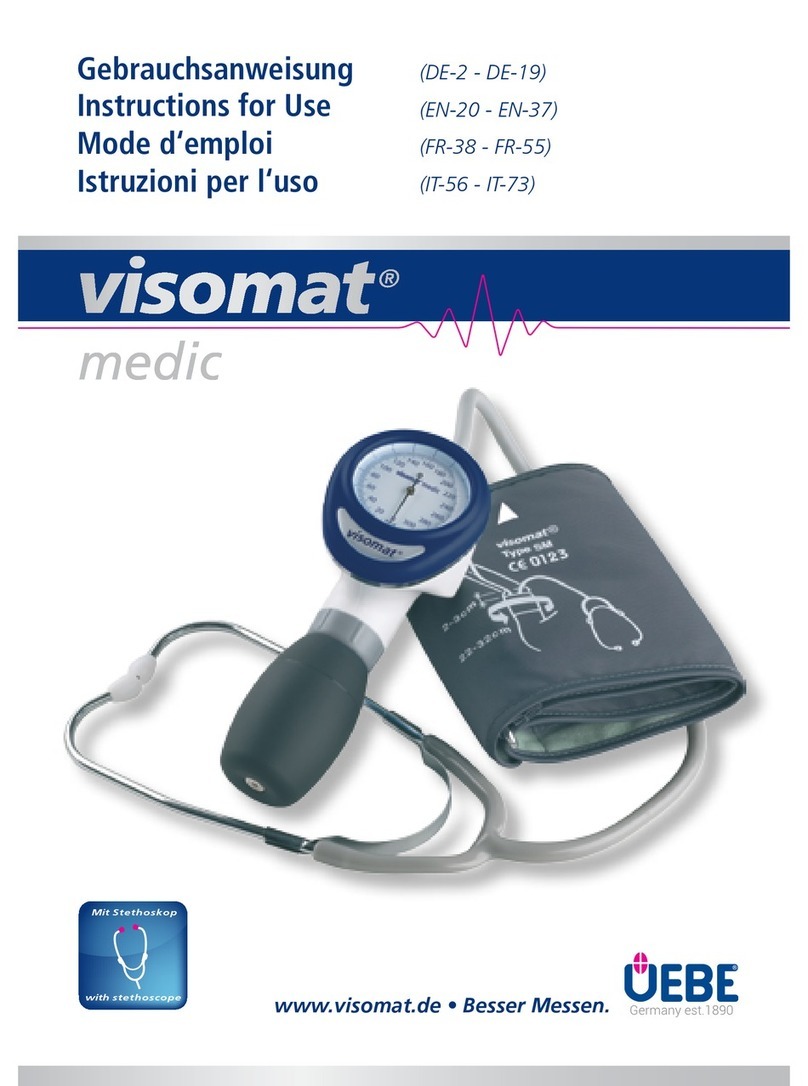
visomat
visomat Medic User manual

visomat
visomat comfort III User manual
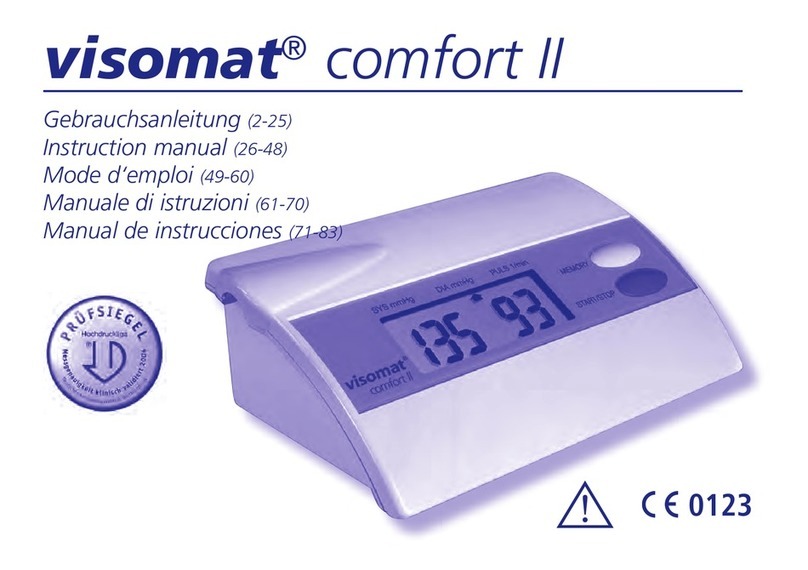
visomat
visomat comfort II User manual
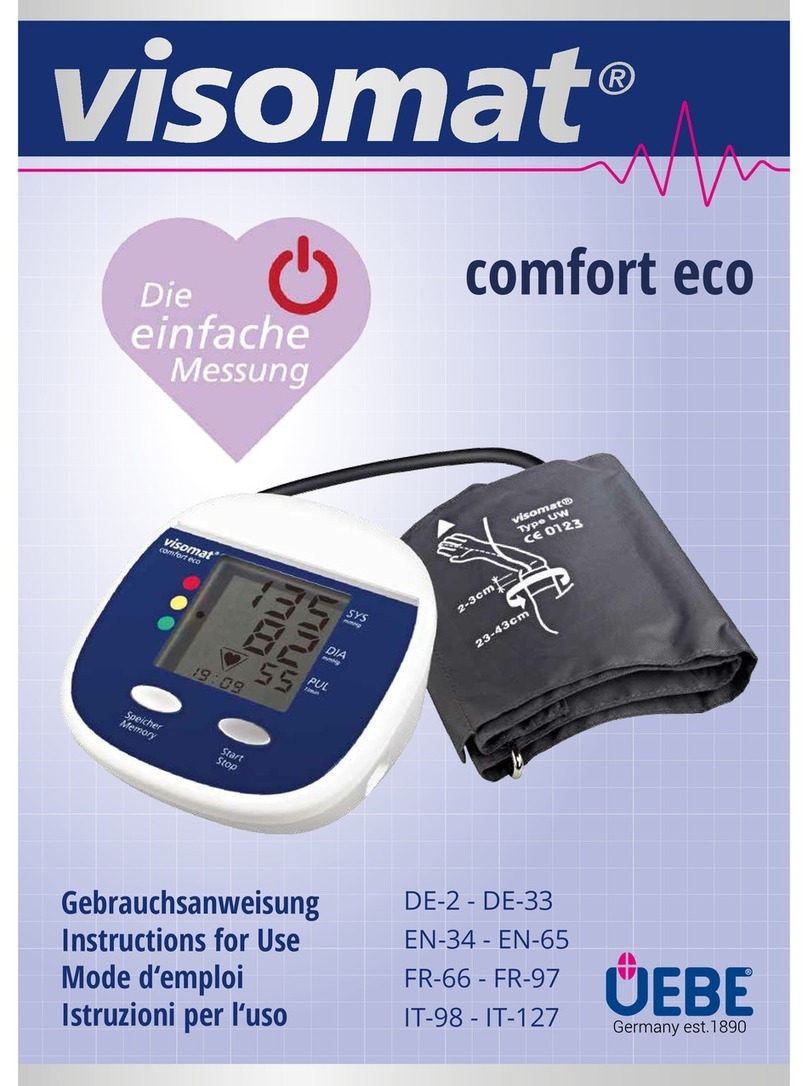
visomat
visomat comfort eco User manual
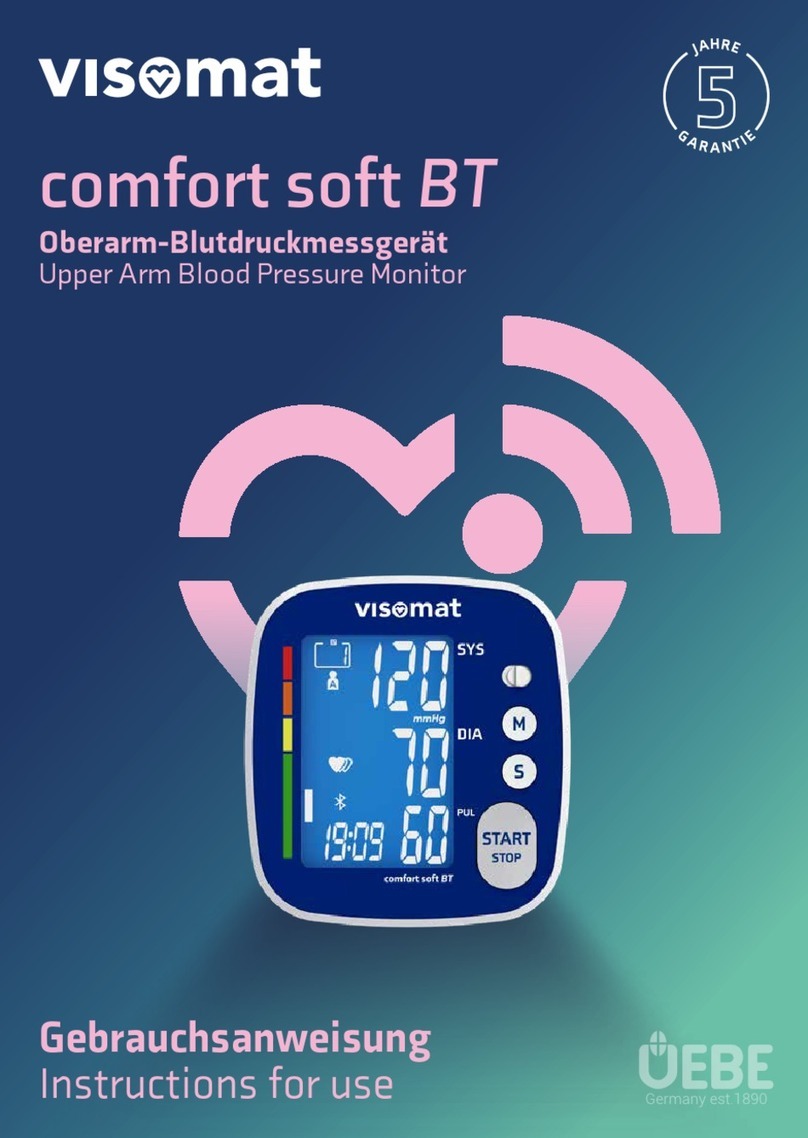
visomat
visomat comfort soft BT User manual
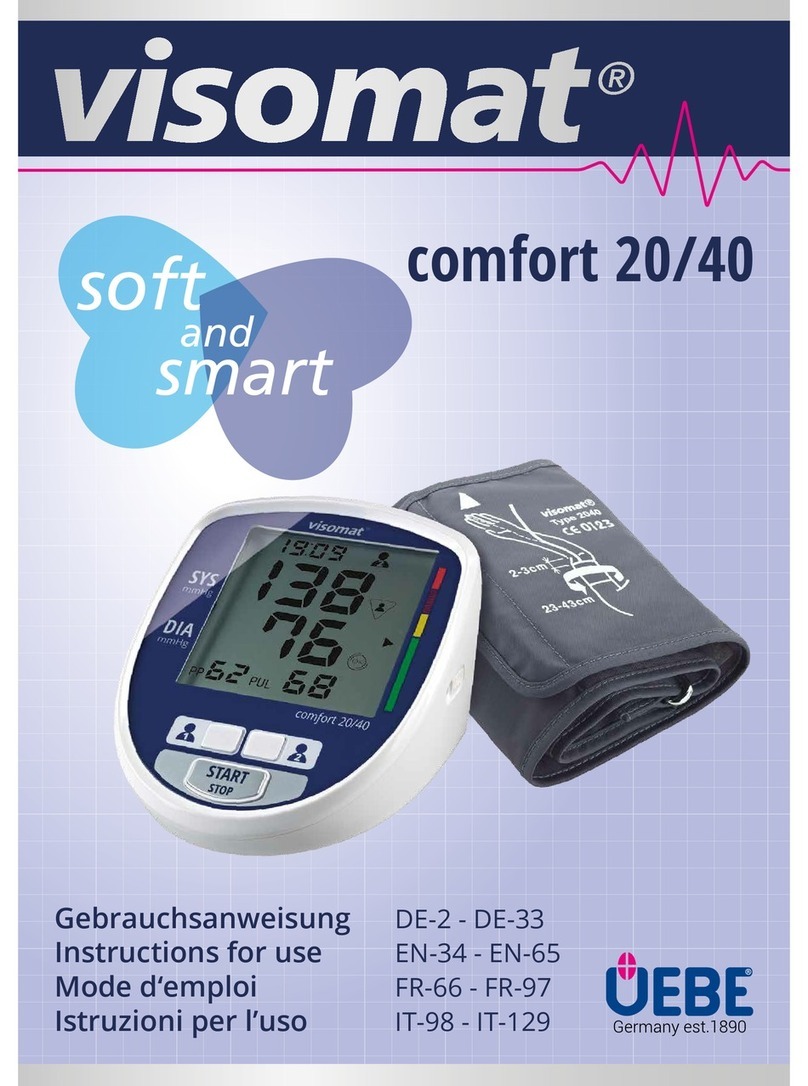
visomat
visomat comfort 20 User manual
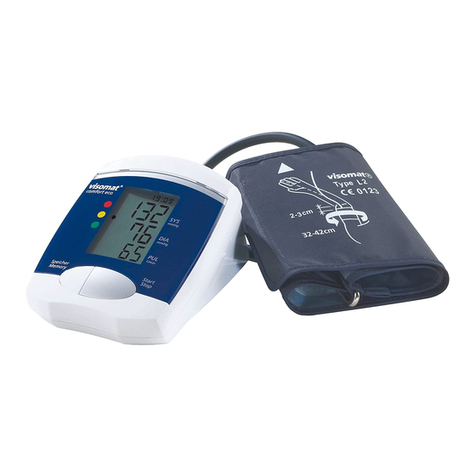
visomat
visomat comfort eco User manual

visomat
visomat Medic User manual
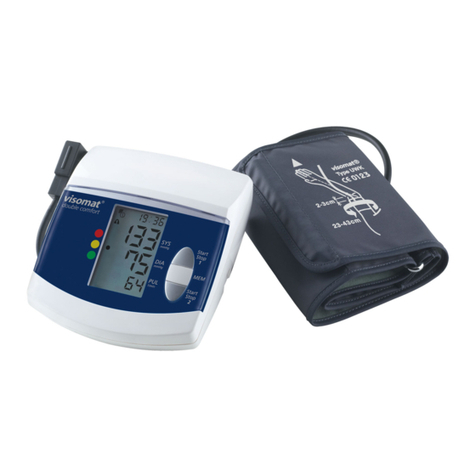
visomat
visomat double comfort User manual
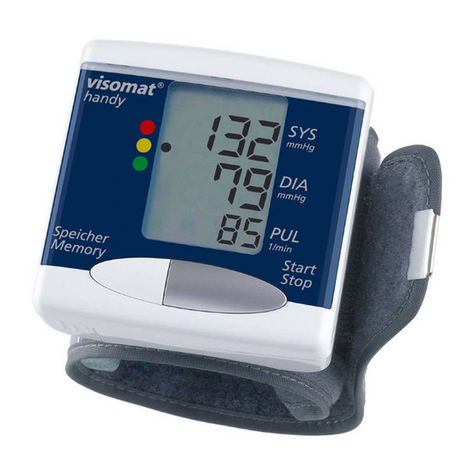
visomat
visomat handy User manual

















